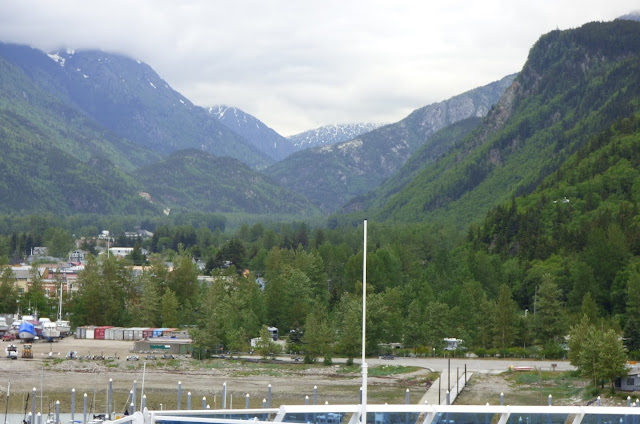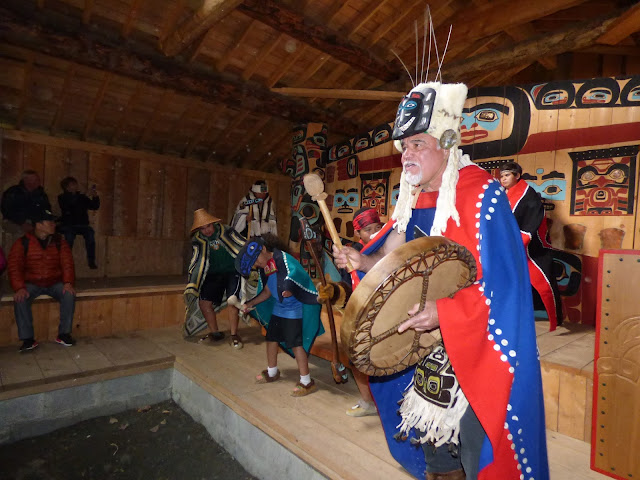We arrived in Skagway before we were even up this morning. Since our 7:00 am tour had been changed to 1:00 we just slept in and then had a very relaxed breakfast time in the Horizon Court - the buffet on the ship. It was quite windy, cool (48) and overcast so we felt no need to get off and wander the town that was nearby so we just enjoyed our view from our room (note all the painted rocks most of which are symbols for various cruise ships)
That was the only thing we were curious about so when we did get off in anticipation of our tour we walked down to check it out. It still looked the same (though not many RVs since it is so early in the season) and helped us do a little reminiscing when we were parkers for our Winnebago caravan. We were there several days and in the evening would sit out side the gate facing the dock to watch the cruise ships move out.
Our tour took us on a 45 minute fast ferry ride
to Haines in the Chilkat Valley. To get there you travel the same waterway, Lynn Channel, as the ship does going from Skagway to Juneau and Ketchikan. So you see much the same stuff we saw on our trip in a small boat back in 2009 when we traveled with our Alaska caravan group to Juneau. Along the way we saw many of the same waterfalls as well as seals, whales and eagles. I wasn't as successful getting pictures this time but this is the kind of stuff we saw. (Fast ferries don't slow down so you can take pictures)
Haines is over 350 miles from Skagway by road so most people choose to go there by boat. It was home to an army base, Fort Stewart, built in 1903 to help resolve disputes with Canada and later sold to Army veterans and now used for a variety of things - especially visitor housing in the officer row of homes.
In 1896 when gold was discovered in Alaska this was home to over 100,000 gold seekers and filled with tent homes while they gathered the necessary equipment for moving on. Today it is home to about 2,500 residents. But over 11,000 years ago the Chilkat and Chilkoot tribes of Tlingit Indians had crossed the ice bridge at the Bering Strait and made this area their home. It was fantastic for fishing as the Chilkoot River at the base of the mountains never freezesand fishing became their major source of food. All five kinds of salmon can be found in this river which also attracts bald eagles who make this area their home - as many as a thousand or more. Forty-eight thousand acres were declared the Chilkat Bald Eagle Preserve by the governor in 1983.
We stopped for a short visit at the American Bald Eagle Foundation to visit a few raptors of the area that are being treated for wounds so in cages.
This eagle had injured feet and problems with one wing
And this barred owl was quite intrigued with us choosing to sit right at the front of the cage and stare at us.
The main caretaker brought this owl out for us all to see.
Our bus trip took us along the side the river and preserve area as we traveled to the Jilkaat Kwaan Cultural and Heritage Center which just opened last week in the village of Klukwan. In fact, one of the members of the tribe was on our bus and was able to tell us a bit about what we would be seeing. Some of the ancient pieces are considered sacred and we were asked not to take pictures of them.
Living in this area so abundant in fish, game, edible plants, and wild berries allowed the Tlingit to develop a rich culture and establish an empire that extended by land and sea from interior Alaska and Canada to California. The are known for their trading, oratory, and arts and crafts. The traditions of Tlingits are still recognized and practiced today, such as Chilkat and Raven's Tail weaving, wood carving, spruce root and cedar basket making and story telling. Our guide was instrumental in getting this Center up and running and helped to provide some of the examples of the arts by making them herself - especially the fantastic weavings.
She first took us to the area that shows how the fish were caught, cleaned, dried and smoked.
Then we visited the carving and wood area where long canoes are created as well as totems and other wooden art objects such as tribal head pieces.
This fellow showed us the tool he created to remove the surface of wood to make it much more resistant to wood rot caused by water.
From there we visited the clan house with its ancient (over 500 year old totems)
Here we were treated to a show demonstrating some of the dances and costumes warn while doing them.
And from there we went to the museum which was off limits to the camera but so many neat things to see inside. These people are very artistic and it sure shows in the things they had on display along with a huge map of their homelands and their history time line.
There was a small shop that sold a few handcrafted items along with a book about the life of this tribe written by our guide that several people purchased.
Then we went outside where tables were set up with a light meal for us to enjoy while watching the rapidly moving water and the Eagle Preserve area on the other side trying to spot one in flight or sitting on a branch.
On our way back to the port and the ferry, we passed a moose and her couple day old baby alongside the rode. Then we said farewell to Haines
and our ship, the Coral Princess.
It was well past our dinner hour so we simply went up to the Horizon Court for the buffet supper and then returned to our room to relax for a bit before calling it a night while the ship pulled away and began the trip to our next destination, Juneau.






























No comments:
Post a Comment